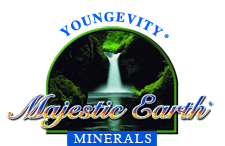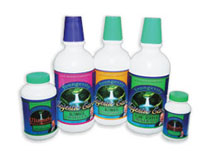

| BIOMETRICS | BEYOND ORGANIC | BLOOD/SUGAR | PROBIOTICS | DETOX | EFA's | |
| MULTI VITAMINS | MINERALS | JUST VITAMINS | INTEGRIS | SHAKES | SOZO PRODUCTS | FREELIFE |

|
OSTEOPOROSIS AND ORAL BONE LOSS PREVENTION by Seymour L. Gottlieb, BS, BDS, DDS, member of NOHA's Professional Advisory Board, retired from a private practice in Dentistry in Northbrook, Illinois; former Research Assistant and Instructor, College of Dentistry, University of Illinois and Researcher in Microbiology, United States Public Health Service, Center for Disease Control. Osteoporosis is the most common metabolic bone disease in the United States. Over ten million people have osteoporosis, eighty percent being women. Another eighteen million are at risk due to having a low level of calcium and phosphorus minerals in their bones. Five million are men who have either low bone density or outright osteoporosis. The National Institutes of Health has just embarked upon a seven-year study, coordinated at seven universities to study bone mass and risk factors in men. Osteoporosis is a systemic skeletal disease characterized by a reduced amount of calcium and phosphorus in bone causing reduced strength and impairment of bone formation and reduced strength. It can occur at all ages and in all populations. An average adult has about 2.2 pounds (1000 grams) of calcium. We lose calcium through sweat, urine, feces, and bone remodeling. Bone is a living tissue made up of an inner and outer layer of bone and a bone marrow core, which produces blood cells. It is made up of calcium, phosphorus, and other minerals with nerves and blood vessels running through it. Bone functions to support the weight of the body as well as to store calcium and phosphorus. Bones and teeth hold about ninety-nine percent of the body’s calcium. The remaining one percent circulates in the blood. When the calcium level in the blood drops, bone remodels releasing more calcium to maintain a balance of minerals in the blood. Five to ten percent of the calcium in our bones is replaced (remodeled) annually. None can ever be removed from the teeth.
During childhood, bone is built up more rapidly than it is broken down. In the late twenties, this process becomes nearly balanced. By the mid-thirties, women lose more bone mass at a rate of about one-half percent a year until menopause. Women lose one to five percent of their bone mass annually during the first few years of menopause and then lose it more slowly. Women are at a higher risk after menopause because they stop producing estrogen, which retards bone loss. One out of four after menopause and ninety percent of women over seventy-five have osteoporosis. An increase in prevalence of osteoporosis correlates with increasing life span. Osteoporosis occurs when bones lose more of their bone mass than is formed and then become brittle. The main complication of osteoporosis is bone fractures. Osteoporosis is responsible for 1.3 million fractures in the United States annually. Fourteen percent of fifty-year-old white females are expected to have hip fractures in their lifetime. For every five years increase in age after sixty-five, there is a forty percent increase in the risk of hip fracture. Fracture complications kill as many women each year as does breast cancer. Genetic and systemic factors are strong influences in the development of osteoporosis as are nutrition, environment and lifestyles. While there is no cure, early preventive measures can prevent or substantially reduce its impact. The National Institutes of Health 2000 Osteoporosis Conference reported that low estrogen levels, high dietary protein, plus caffeine, phosphorus, sodium, and smoking all adversely affect the calcium balance. Low levels of vitamin D and calcium are common in aging populations. Exercise reduces by twenty-five percent the risk of osteoporosis.
Bone loss in the oral cavity is also a significant problem with age. As much as ninety four percent of United States women over sixty-five have dental bone loss. Both osteoporosis and oral bone loss are asymptomatic and diagnosis usually is made after a problem exists. Both result in significant bone loss in middle-aged or older persons. At the cellular level, these two diseases have many of the same pathological mechanisms that cause bone resorption.
Dentists are often asked: (1) Does osteoporosis affect the upper and lower jaw? (2) How is the progress of periodontal disease affected when a person has osteoporosis? (3) What preventive and treatment strategies would be beneficial to maximize oral bone health and limit osteoporosis? (1) Findings pertaining to the upper and lower jaws:_two_aspects_will be considered: Bone of the jaw where teeth are missing (residual ridge) The relationship between osteoporosis and the jaws’ residual ridge was first observed in 1990. Researchers correlated the severity of osteoporosis with the degree of residual ridge resorption. In 1993, another study of patients with all teeth missing further confirmed that oral oral bone loss correlates with skeletal bone mass. Osteoporotic people lose more teeth than similarly matched non-osteoporotic people. A very recent study demonstrated that the upper jaw is composed of bone structure that is more susceptible than the lower jaw. Bone changes in the jaws parallel changes found in other bones in normal aging. Bone that surrounds and supports teethThis is the only place where periodontal disease can occur. The initiation of periodontal disease does not depend on the general mineral density of the other bones in the body. Bone loss immediately around the teeth is primarily caused by local factors not present elsewhere in the body. These include bacterial plaque, calculus [mineral deposits on teeth], appliances worn, trauma, and home care. (2) Osteoporosis and dental diseases Osteoporosis does not cause gingivitis (inflammation of the gums) or tooth mobility. However, one report states that individuals with osteoporosis, heavy calculus formation, and severe periodontal disease do have more tooth support loss than similar non-osteoporotic patients. Another study states that women with high bone mineral values retain teeth with deep periodontal recession pockets longer than women with low mineral density (osteoporosis). (3) Preventive treatment Osteoporosis is preventable and not an inevitable consequence of aging. We can start protecting our bones immediately with healthy habits. One must combine dietary and lifestyle changes. In exercise, muscle pressure stimulates the bones to absorb calcium and grow stronger. Americans spend a smaller percent of their income on food than any other nation on earth. according to Healthy People 2001, Forty percent of a family’s food budget is now spent in restaurants or on carry-out meals. Such foods are generally higher in fat and sodium and lower in calcium and fiber. Fast food chains market their products in public schools through lunchroom franchises, teaching materials, and advertising contracts. Beverage companies have contracts with school districts and universities amounting to hundreds of millions of dollars per year. In Kansas City, schools negotiated contracts paying twenty-seven dollars per student per year. The average American drinks fifty-six gallons of soda a year, which is equivalent to six hundred twelve-ounce cans. Each sugar-sweetened can contains ten teaspoons of sugar providing empty calories while replacing more nutritious drinks. Excess soda consumption increases phosphorus intake, which adds to a calcium deficiency by affecting the body’s desired calcium-to-phosphorus ratio. In addition, the United States Census Bureau estimates that thirty-one million Americans don’t know if they will have enough groceries to last the month. Food stamp benefits in the United States average seventy-one dollars per month for each person, allowing only eighty cents per person per meal.
The benefits of calcium supplementation begin to fade in one to two years after you stop taking them unless calcium foods in your diet are equivalent. To maintain bone density, calcium and its related bone-building minerals must be taken indefinitely. Magnesium is very important in influencing mineral metabolism directly or through its effect on hormones. Inadequate magnesium intake can limit bone growth and increase bone fragility. Calcium supplementation without magnesium may result in greater demineralization activity. An ideal range for a ratio of intake for the two minerals is two parts calcium to one part magnesium or, in some cases, a one-to-one ratio. The National Academy of Sciences in 1997 suggested 1000 milligrams (mg) each day of calcium intake for men and women over twenty-five years-of-age increasing to 1200 mg over age fifty-one and for teenage girls. Others recommend 1500-1800 mg. each day for the latter group and lactating women. Other important nutrients that aid calcium deposition and bone formation are:
Food sources of calcium for the vegan include:
A New England Journal of Medicine study reported a forty-three percent reduction in bone loss in postmenopausal women who supplemented regular diets with 1000 mgs of calcium for two years. Intestinal absorption of calcium declines with age in both sexes. Low gastric acid, large quantities of fiber, medications, diuretics, or alcohol can interfere with calcium absorption. A three-ounce portion of meat provides about twenty milligrams of protein. A diet excessive in protein can also be detrimental to bone. To digest protein, acids are released into the blood stream. To neutralize these acids, the body must remove calcium from the bone. Women are recommended to have forty-five to fifty-five grams of protein a day and fifty-five to sixty-five grams for men. Osteoporosis is a risk factor for oral bone loss. Bone density changes in the jaw parallel changes found in other bones in normal aging. Skeletal bone density is related to jaw bone loss especially in postmenopausal women. No association was observed in women with low or intermediate amounts of calculus. No relationship of osteoporosis with the etiology of periodontal disease has been found. Professional along with personal home care is most effective in controlling periodontal disease in both osteoporotic and non-osteoporotic individuals. All factors that optimize bone health must be included at all times. Simply ingesting calcium and vitamin D will not reduce your risk. Having a bone mineral density test can help you determine your status. ______________ Bibliography "Conference Statement, Osteoporosis, Prevention, Diagnosis, Therapy," ADA (American Dental Association) News, 3(8), April 17, 2000. Consumer Reports of Health, "Can Gum Disease Harm the Lungs?" August 2001. Skavkin, Harold, "First Encounters: Transmission of Infectious Oral Diseases from Mother to Child," Journal of the American Dental Association, 128: 773-8, 1997. Heersche, J. et al, "The Decrease in Bone Mass Associated with Aging and Menopause," Journal of Prosthetic Dentistry, 79(1):14-6, January 1998. Loza, J., Carpio, L. and Dziak, R., "Osteoporosis and its Relationship to Oral Bone Loss," Periodontology, 3: 27-33, 1996. Tagochi, A., et al, "Tooth Loss and Mandibular Osteopenice," Oral Surgery, Oral Medicine, Oral Pathology, Oral Radiology Endodontics, 79: 127-132, 1995. Torrens, J and Duncan, War., "Osteoporosis and Oral Bone Loss: An Update for the Dental Professional," Practical Hygiene 6(3): 45-8, 1997. Kresci, C., "Osteoporosis and Periodontal Disease: Is There a Relationship?" Periodontal Abstracts, 44(2): 3742, 1996. Shalom, C., "Osteoporosis and Periodontal Bone Loss," Naval Dental School, Bethesda, MD, Clinical Update 17(3): 53-4, September 1995. Randeros, M., et al, "Associations of Periodontal Disease With Femoral Bone Mineral Density and Estrogen Replacement Therapy, Cross-sectional Evaluation of US Adults From NHA NES II, " Journal of. Clinical Periodontistry, 27: 278-86, 2000. Southard, K., "Bone Density Changes in the Jaw," Journal of Dental Research, April 2000 and University of Iowa, Dental Link, 79(4): 964-9, Fall 2000. Tezal, M. et al, "The Relationship Between Bone Mineral Density and Periodontitis in Postmenopausal Women," Journal of Periodontics, 71(9): 1492-7, September 2000. Wynn, R., "Osteoporosis, Alvelar Bone Loss and Drug Development," Journal of General Dentistry, 48(3): 218-22, May-June 2000. Slavkin, H., "Building a Better Mousetrap: Toward An Understanding of Osteoporosis," Journal of the American Dental Association, 130:1632-6, November 1999. Toews, V., "Strong to the Bone," Healthy Lifestyles, pages 4,10, Summer 2001. Sclosser, Eric, Fast Food Nationer, Houghton-Mifflin Company, 2001.Hankinson, S. et al, Healthy Women, Healthy Lives, Simon & Schuster, 2001.Center for Science in the Public Interest, Nutrition Action Newsletter, September 2001. Vegetarian Times, March and June, 2001. Hannan, M. T., "Effective Dietary Protein on Bone Loss in Elderly Men and Women,"Journal of Bone and Mineral Research, 15(12): 2504-12, December 2000. King, Janet, "Does Poor Zinc Nutrition Retard Skeletal Growth and Mineralization in Adolescents?" American Journal of Clinical Nutrition, 64: 375-6, 1996. Reid, I. et al, "Effect of Calcium Supplementation on Bone Loss in Postmenopausal Women," New England Journal of Medicine, 328: 460-4, 1993. Article from NOHA NEWS, Vol. XXVI, No. 4, Fall 2001, page 4. |

Doctor Joel Wallach and his Pig Pack Formula can be for those that are one of the 20 million Americans who has listened to Doctor Wallachs "Dead Doctors Don't Lie! - the audio tape by Dr. Joel Wallach, BS, DVM, ND, The Mineral Doctor? Doctor Wallach has advocated that this formula may comfort those with artthritis pain and associated joint problems. Pig Pack Formula from Youngevityy has made ordering the products for the Pig Pack Formula much easier. You can buy all those products at one time. Included in the pig pack is 2 Majestic Earth Minerals #13203, 2 Majestic Earth Ultimate Tangy Tangerine #13221, 1 Ultimate Gluco Gel #21251 and 1 Ultimate E.F.A. #20641 . Look also at our
Liquid
Gluco Gel with MSM,
Glucosame Sulfate, Chondroitin Sulfate, Cetylmyristoleate, and
Collagen Hydrolysate. Check out Liquid
Osteo fx an easy way to get your 1200mg of Daily Calcium
with MSM and Glucosame Sulfate.

|
||||||||||||||||||||||||||||||||||||||||||

